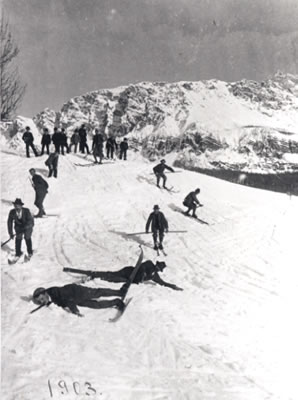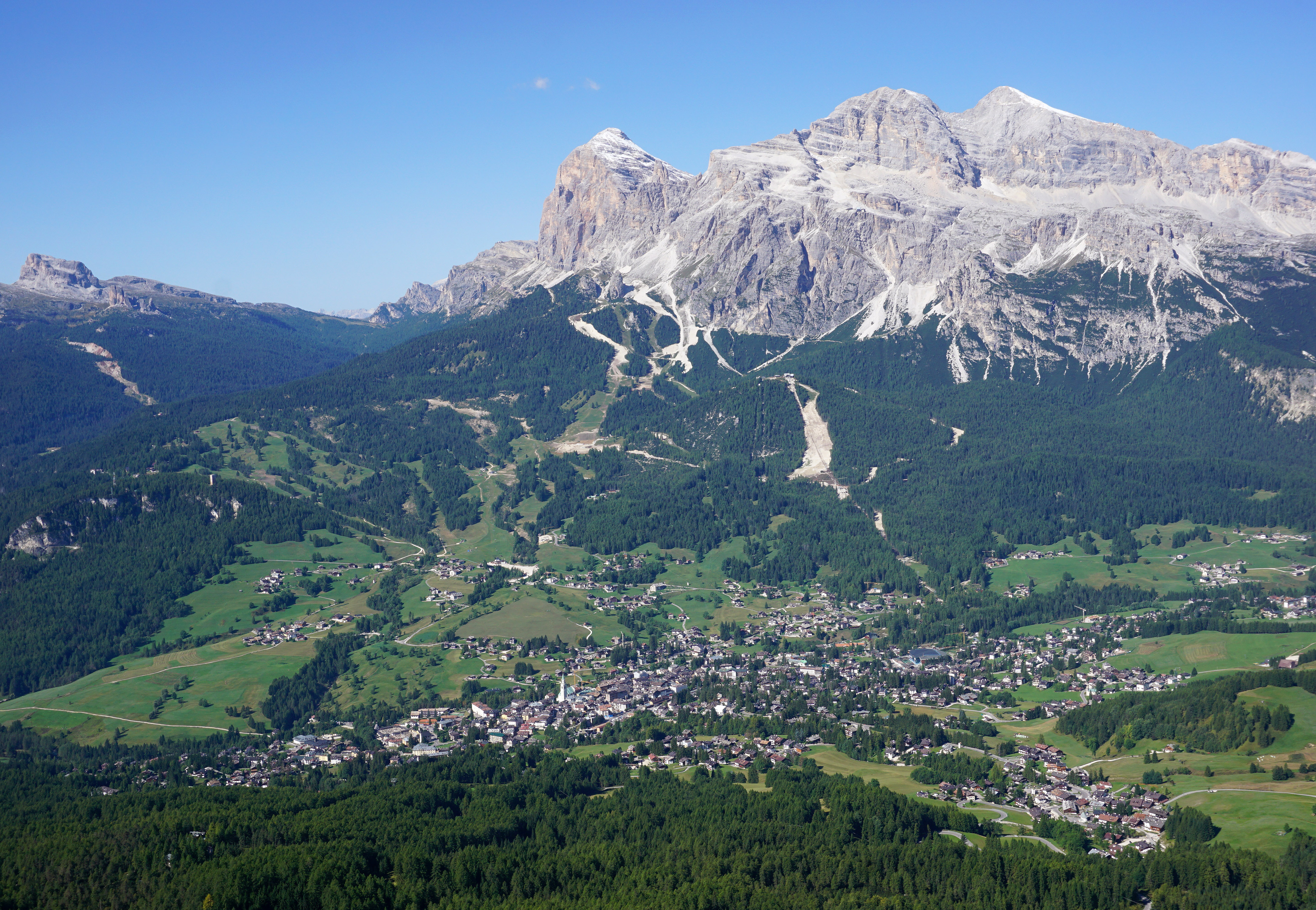|
Castello De Zanna
The Castello de Zanna is a small fortress, situated in the ''frazione'' of Majon, in the ''comune'' of Cortina d'Ampezzo in the southern (Dolomitic) Alps of the Veneto region of Northern Italy Northern Italy ( it, Italia settentrionale, it, Nord Italia, label=none, it, Alta Italia, label=none or just it, Nord, label=none) is a geographical and cultural region in the northern part of Italy. It consists of eight administrative regions .... It consists of low, white outer walls and two white corner towers, with a small chapel dedicated to the Holy Trinity. The construction of the castle began in 1694, but on August 19, 1696, work was interrupted; the building remained unfinished in 1809 when it was burned by French revolutionary troops who had invaded Ampezzo. Since then the castle has undergone restoration. References Forts in Italy Buildings and structures in Cortina d'Ampezzo 1694 establishments in Italy {{Italy-castle-stub ... [...More Info...] [...Related Items...] OR: [Wikipedia] [Google] [Baidu] |
Cortina D'Ampezzo
Cortina d'Ampezzo (; lld, Anpezo, ; historical de-AT, Hayden) is a town and ''comune'' in the heart of the southern (Dolomitic) Alps in the Province of Belluno, in the Veneto region of Northern Italy. Situated on the Boite river, in an alpine valley, it is a summer and winter sport resort known for its skiing trails, scenery, accommodation, shops and après-ski scene, and for its jet set and Italian aristocratic crowd. In the Middle Ages, Ampezzo fell under the jurisdiction of the Patriarchate of Aquileia and of the Holy Roman Empire. In 1420 it was conquered by the Republic of Venice. From 1508, it then spent much of its history under Habsburg rule, briefly undergoing some territorial changes under Napoleon, before being returned to the Austrian Empire (later Austria-Hungary), which held it until 1918. From the nineteenth century, Ampezzo became a notable regional centre for crafts. The local handmade products were appreciated by early British and German holidaymakers as ... [...More Info...] [...Related Items...] OR: [Wikipedia] [Google] [Baidu] |
Dolomites
The Dolomites ( it, Dolomiti ; Ladin: ''Dolomites''; german: Dolomiten ; vec, Dołomiti : fur, Dolomitis), also known as the Dolomite Mountains, Dolomite Alps or Dolomitic Alps, are a mountain range located in northeastern Italy. They form part of the Southern Limestone Alps and extend from the River Adige in the west to the Piave Valley (Pieve di Cadore) in the east. The northern and southern borders are defined by the Puster Valley and the Sugana Valley (Italian: ''Valsugana''). The Dolomites are located in the regions of Veneto, Trentino-Alto Adige/Südtirol and Friuli Venezia Giulia, covering an area shared between the provinces of Belluno, Vicenza, Verona, Trentino, South Tyrol, Udine and Pordenone. Other mountain groups of similar geological structure are spread along the River Piave to the east – ''Dolomiti d'Oltrepiave''; and far away over the Adige River to the west – ''Dolomiti di Brenta'' (Western Dolomites). A smaller group is called ''Piccole Dolomiti'' (Li ... [...More Info...] [...Related Items...] OR: [Wikipedia] [Google] [Baidu] |
Alps
The Alps () ; german: Alpen ; it, Alpi ; rm, Alps ; sl, Alpe . are the highest and most extensive mountain range system that lies entirely in Europe, stretching approximately across seven Alpine countries (from west to east): France, Switzerland, Italy, Liechtenstein, Austria, Germany, and Slovenia. The Alpine arch generally extends from Nice on the western Mediterranean to Trieste on the Adriatic and Vienna at the beginning of the Pannonian Basin. The mountains were formed over tens of millions of years as the African and Eurasian tectonic plates collided. Extreme shortening caused by the event resulted in marine sedimentary rocks rising by thrusting and folding into high mountain peaks such as Mont Blanc and the Matterhorn. Mont Blanc spans the French–Italian border, and at is the highest mountain in the Alps. The Alpine region area contains 128 peaks higher than . The altitude and size of the range affect the climate in Europe; in the mountains, precipitation ... [...More Info...] [...Related Items...] OR: [Wikipedia] [Google] [Baidu] |
Veneto
Veneto (, ; vec, Vèneto ) or Venetia is one of the 20 regions of Italy. Its population is about five million, ranking fourth in Italy. The region's capital is Venice while the biggest city is Verona. Veneto was part of the Roman Empire until the 5th century AD. Later, after a Feudalism, feudal period, it was part of the Republic of Venice until 1797. Venice ruled for centuries over one of the largest and richest maritime republics and trade empires in the world. After the Napoleonic Wars and the Congress of Vienna, the Republic was combined with Lombardy and annexed to the Austrian Empire as the Kingdom of Lombardy–Venetia, until that was Italian unification, merged with the Kingdom of Italy in 1866, as a result of the Third Italian War of Independence. Besides Italian language, Italian, most inhabitants also speak Venetian language, Venetian. Since 1971, the Statute of Veneto has referred to the region's citizens as "the Venetian people". Article 1 defines Veneto as an " ... [...More Info...] [...Related Items...] OR: [Wikipedia] [Google] [Baidu] |
Northern Italy
Northern Italy ( it, Italia settentrionale, it, Nord Italia, label=none, it, Alta Italia, label=none or just it, Nord, label=none) is a geographical and cultural region in the northern part of Italy. It consists of eight administrative regions: Aosta Valley, Piedmont, Liguria, Lombardy, Emilia-Romagna, Veneto, Friuli-Venezia Giulia and Trentino-Alto Adige. As of 2014, its population was 27,801,460. Rhaeto-Romance and Gallo-Italic languages are spoken in the region, as opposed to the Italo-Dalmatian languages spoken in the rest of Italy. The Venetian language is sometimes considered to be part of the Italo-Dalmatian languages, but some major publications such as '' Ethnologue'' (to which UNESCO refers on its page about endangered languages) and '' Glottolog'' define it as Gallo-Italic. For statistic purposes, the Istituto Nazionale di Statistica (ISTAT) uses the terms Northwest Italy and Northeast Italy for two of Italy's five statistical regions in its reporting. These same su ... [...More Info...] [...Related Items...] OR: [Wikipedia] [Google] [Baidu] |
Forts In Italy
A fortification is a military construction or building designed for the defense of territories in warfare, and is also used to establish rule in a region during peacetime. The term is derived from Latin ''fortis'' ("strong") and ''facere'' ("to make"). From very early history to modern times, defensive walls have often been necessary for cities to survive in an ever-changing world of invasion and conquest. Some settlements in the Indus Valley civilization were the first small cities to be fortified. In ancient Greece, large stone walls had been built in Mycenaean Greece, such as the ancient site of Mycenae (famous for the huge stone blocks of its 'cyclopean' walls). A Greek '' phrourion'' was a fortified collection of buildings used as a military garrison, and is the equivalent of the Roman castellum or English language, English fortress. These constructions mainly served the purpose of a watch tower, to guard certain roads, passes, and borders. Though smaller than a real fo ... [...More Info...] [...Related Items...] OR: [Wikipedia] [Google] [Baidu] |
Buildings And Structures In Cortina D'Ampezzo
A building, or edifice, is an enclosed structure with a roof and walls standing more or less permanently in one place, such as a house or factory (although there's also portable buildings). Buildings come in a variety of sizes, shapes, and functions, and have been adapted throughout history for a wide number of factors, from building materials available, to weather conditions, land prices, ground conditions, specific uses, prestige, and aesthetic reasons. To better understand the term ''building'' compare the list of nonbuilding structures. Buildings serve several societal needs – primarily as shelter from weather, security, living space, privacy, to store belongings, and to comfortably live and work. A building as a shelter represents a physical division of the human habitat (a place of comfort and safety) and the ''outside'' (a place that at times may be harsh and harmful). Ever since the first cave paintings, buildings have also become objects or canvasses of much artis ... [...More Info...] [...Related Items...] OR: [Wikipedia] [Google] [Baidu] |





